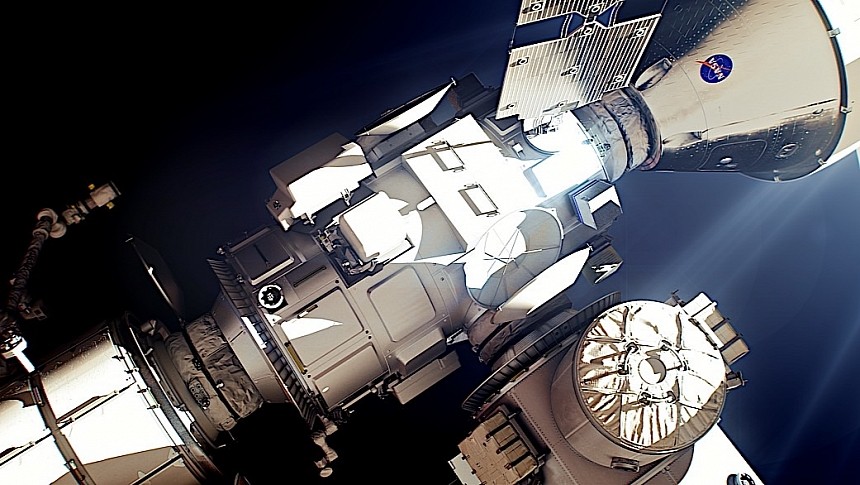I recently finished re-watching Amazon's "The Expanse" and because of that every time I am now faced with news about Mars or the Moon I get all worked up. It's a phase, I'm sure, but for the moment it allows me to look at the future of humanity in space from an entirely new perspective.
Just to remind you what The Expanse is all about it's enough to say the series offers a rare insight into how humanity will take over the solar system. It's an exaggerated insight at times but overall, at least to me, it seems just about right.
The series depicts a not-so-distant future (2350s) when humanity colonized the Moon, Mars, and the Asteroid Belt. But we're not a closely-knit system-wide society, but a highly divided one, fighting for every scrap of resource available.
The Earth and Moon (called Luna in the series), allied under the auspices of the UN, are most of the time at war with the Mars Congressional Republic, while the many factions of the Belters (the most prominent being the Outer Planet Alliance) are at war with everybody, including themselves.
Although neither the series nor the books it's based on explicitly says so, the colonization of the solar system in this fictional universe probably started with the Moon, moved on to Mars, and then to the Belt. Which is exactly what we're doing now, in our reality.
The Artemis Moon exploration missions are ambitious in themselves, but to me it's the Gateway project that seems infinitely more important and potentially crucial to our future. That would be the creation of a space station in lunar orbit from where missions to the surface of the Moon and even beyond, to Mars, could be staged and coordinated.
The Gateway will begin assembly soon, with the launch of its first components, the Power and Propulsion Element (PPE) and the habitation and logistic outpost (HALO) planned for launch in 2024. More will be added along the way, increasing the size and scope of the station.
The project is a mammoth effort, requiring the involvement of both government-backed space agencies (NASA, ESA, JAXA) and private companies – SpaceX, Northrop Grumman, or Maxar.
We've seen blueprints of the station before, and even some renderings of it, but none of the images seen so far look as futuristic, Expanse-like, as the image we have here.
Still a rendering, it shows the International Habitat (I-HAB). Together with the HALO it will form the main areas where astronauts will live. It's also the home of life support systems and camera equipment.
And it looks exactly like the modules of the many The Expanse space stations and surface outposts. So much so, in fact, it makes one wonder what else did the writers get right. Only time will tell.
The series depicts a not-so-distant future (2350s) when humanity colonized the Moon, Mars, and the Asteroid Belt. But we're not a closely-knit system-wide society, but a highly divided one, fighting for every scrap of resource available.
The Earth and Moon (called Luna in the series), allied under the auspices of the UN, are most of the time at war with the Mars Congressional Republic, while the many factions of the Belters (the most prominent being the Outer Planet Alliance) are at war with everybody, including themselves.
Although neither the series nor the books it's based on explicitly says so, the colonization of the solar system in this fictional universe probably started with the Moon, moved on to Mars, and then to the Belt. Which is exactly what we're doing now, in our reality.
The Artemis Moon exploration missions are ambitious in themselves, but to me it's the Gateway project that seems infinitely more important and potentially crucial to our future. That would be the creation of a space station in lunar orbit from where missions to the surface of the Moon and even beyond, to Mars, could be staged and coordinated.
The Gateway will begin assembly soon, with the launch of its first components, the Power and Propulsion Element (PPE) and the habitation and logistic outpost (HALO) planned for launch in 2024. More will be added along the way, increasing the size and scope of the station.
The project is a mammoth effort, requiring the involvement of both government-backed space agencies (NASA, ESA, JAXA) and private companies – SpaceX, Northrop Grumman, or Maxar.
We've seen blueprints of the station before, and even some renderings of it, but none of the images seen so far look as futuristic, Expanse-like, as the image we have here.
Still a rendering, it shows the International Habitat (I-HAB). Together with the HALO it will form the main areas where astronauts will live. It's also the home of life support systems and camera equipment.
And it looks exactly like the modules of the many The Expanse space stations and surface outposts. So much so, in fact, it makes one wonder what else did the writers get right. Only time will tell.











